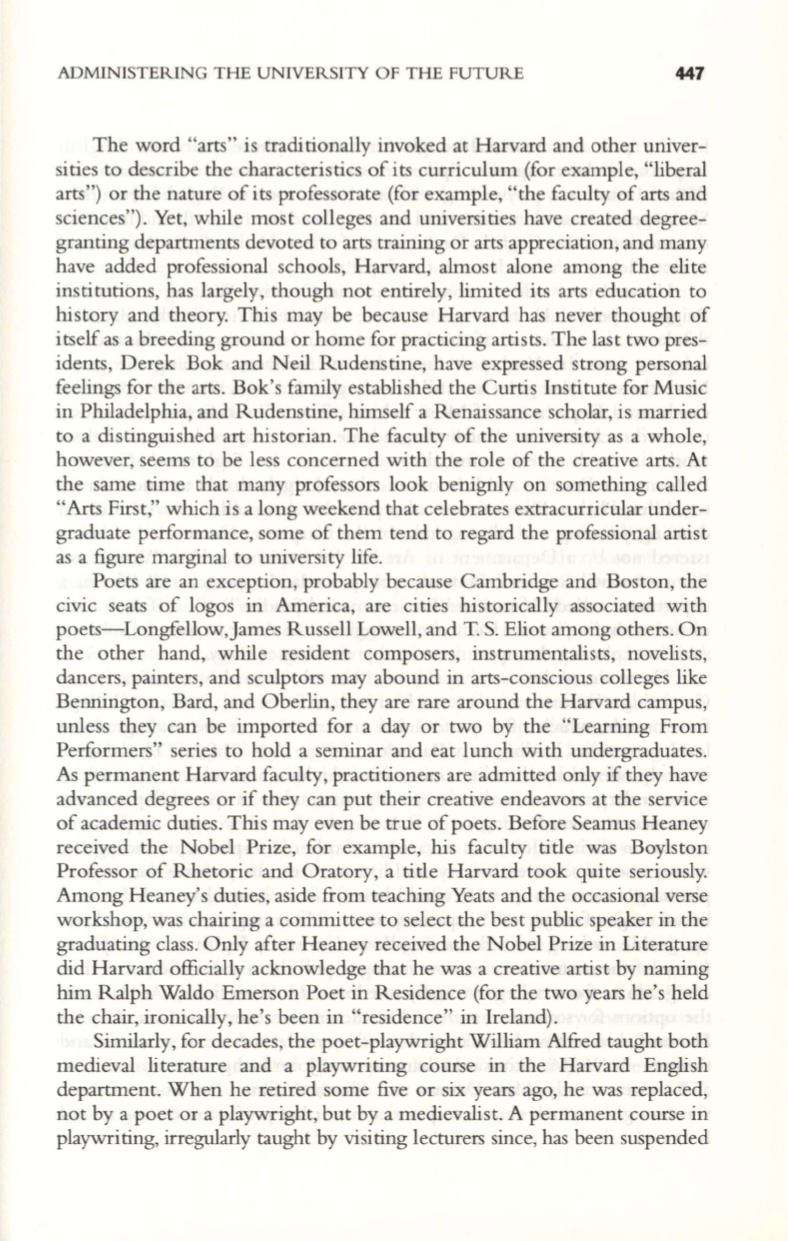
ADMINISTERING THE UNIVERSITY OF THE FUTURE
447
The word "arts" is traditionally invoked at Harvard and other univer–
sities to describe the characteristics of its curriculum (for example, "liberal
arts") or the nature of its professorate (for example, "the faculty of arts and
sciences"). Yet, while most colleges and universities have created degree–
granting departments devoted to arts training or arts appreciation, and many
have added professional schools, Harvard, almost alone among the elite
institutions, has largely, though not entirely, limited its arts education to
history and theory. This may be because Harvard has never thought of
itself as a breeding ground or home for practicing artists. The last two pres–
idents, Derek Bok and Neil Rudenstine, have expressed strong personal
feelings for the arts. Bok's family established the Curtis Institute for Music
in Philadelphia, and Rudenstine, himself a Renaissance scholar, is married
to a distinguished art historian. The faculty of the university as a whole,
however, seems to be less concerned with the role of the creative arts. At
the same time that many professors look benignly on something called
"Arts First," which is a long weekend that celebrates extracurricular under–
graduate performance, some of them tend to regard the professional artist
as a figure marginal to university life.
Poets are an exception, probably because Cambridge and Boston, the
civic seats of logos in America, are cities historically associated with
poets-Longfellow,James Russell Lowell, and
T.
S. Eliot among others. On
the other hand, while resident composers, instrumentalists, novelists,
dancers, painters, and sculptors may abound in arts-conscious colleges like
Bennington, Bard, and Oberlin, they are rare around the Harvard campus,
unless they can be imported for a day or two by the "Learning From
Performers" series to hold a seminar and eat lunch with undergraduates.
As permanent Harvard facul ty, practi tioners are adrni tted only
if
they have
advanced degrees or
if
they can put their creative endeavors at the service
of academic duties. This may even be true of poets. Before Seamus Heaney
received the Nobel Prize, for example, his faculty title was Boylston
Professor of Rhetoric and Oratory, a title Harvard took quite seriously.
Among Heaney's duties, aside from teaching Yeats and the occasional verse
workshop, was chairing a committee to select the best public speaker in the
graduating class. Only after Heaney received the Nobel Prize in Literature
did Harvard officially acknowledge that he was a creative artist by naming
him Ralph Waldo Emerson Poet in Residence (for the two years he's held
the chair, ironically, he's been in "residence" in Ireland).
Similarly, for decades, the poet-playwright William Alfred taught both
medieval literature and a playwriting course in the Harvard English
department. When he retired some five or six years ago, he was replaced,
not by a poet or a playwright, but by a medievalist. A permanent course in
playwriting, irregularly taught by visiting lecturers since, has been suspended


